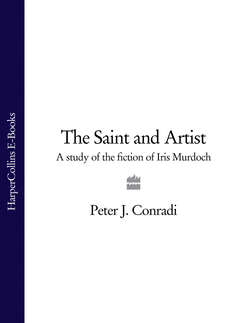The Saint and Artist: A Study of the Fiction of Iris Murdoch

Реклама. ООО «ЛитРес», ИНН: 7719571260.
Оглавление
Peter Conradi J.. The Saint and Artist: A Study of the Fiction of Iris Murdoch
The Saint and Artist. A study of the fiction of Iris Murdoch. Peter J. Conradi
Table of Contents
I ‘A Kind of Moral Psychology’
1 ‘Existentialist and Mystic’
2 Under the Net and the Redemption of Particulars
3 ‘Against Gravity’: The Early Novels and An Accidental Man
4 Eros in A Severed Head and Bruno’s Dream
II ‘Open and Closed’
5 The Sublime in The Bell and The Unicorn
6 Self-Sufficiency in The Time of the Angels and The Nice and the Good
III
7 A Fairly Honourable Defeat
8 The Black Prince
9 The Sacred and Profane Love Machine and Henry and Cato
10 The Sea, The Sea
11 Nuns and Soldiers, The Philosopher’s Pupil and The Good Apprentice
12 The Book and the Brotherhood, The Message to the Planet, The Green Knight and Jackson’s Dilemma
Conclusion
NOTES. Chapter 1
Chapter 2
Chapter 3
Chapter 4
Chapter 5
Chapter 6
Chapter 7
Chapter 8
Chapter 9
Chapter 10
Chapter 11
Chapter 12
Conclusion
SELECT BIBLIOGRAPHY
1. Works by Iris Murdoch
2. Criticism
INDEX
Copyright
About The Publisher
Отрывок из книги
Cover Page
Title Page
.....
Murdoch argued for the centrality of the old naturalistic idea of character for the business of writing novels, and also wrote about the ways in which too great an attention to the form of the book can damage the illusion that the characters are free. In ‘Against Dryness’ and ‘The Sublime and the Beautiful Revisited’ she argued that the task for the novelist was to recreate ‘realism’, which often meant avoiding the bad habits – overt design, patterning, symbol and myth – which damage it. Her fiction, however, appeared to be written by the kind of novelist she least approved of, since it was much preoccupied with pattern, utilised fantasy and myth, and had generally the character implied by the term already used – ‘romance’. This gave criticism its main opportunity. She had written of the novel as if it were a vehicle of human differentiation and belonged to a vast campaign for the preservation of human plurality, and of the novelist as a tender detective of human souls, but herself seemed to write the novel of human resemblances and exciting symbolic conflations. The more open novels were used in England to punish the more closed and Gothic ones, and critics scrutinised the books for delinquent symmetries and wicked coincidences. Alternatively the critic, mindful that Murdoch had urged a distinction between fantasy and imagination, searched the work for ‘fantasy-apprehensions’ like a metaphysical park attendant, as if what was left once these were speared were some pure undiluted essence of the real. We have been given the choice between unmasking the works and denouncing their personnel.
I think criticism has been too absolutist and pious about the early theory. A writer theorises in a particular spirit. She may be trying out a variety of different positions in the effort to understand the shape and nature of her gift, rather than announcing a single unchanging campaign manifesto. The kinship between work and theory is likely to be complex in any writer worth reading. We no longer praise either Wordsworth or Ben Jonson for what, in the Preface to Lyrical Ballads or in Timber, they thought they had put into their work. A relaxed account of Murdoch’s work which does not quarantine off certain works because they are generically diverse is needed. The writer has the right to as much ‘organis’d innocence’ as will enable her work; the critic is not obliged to follow.
.....